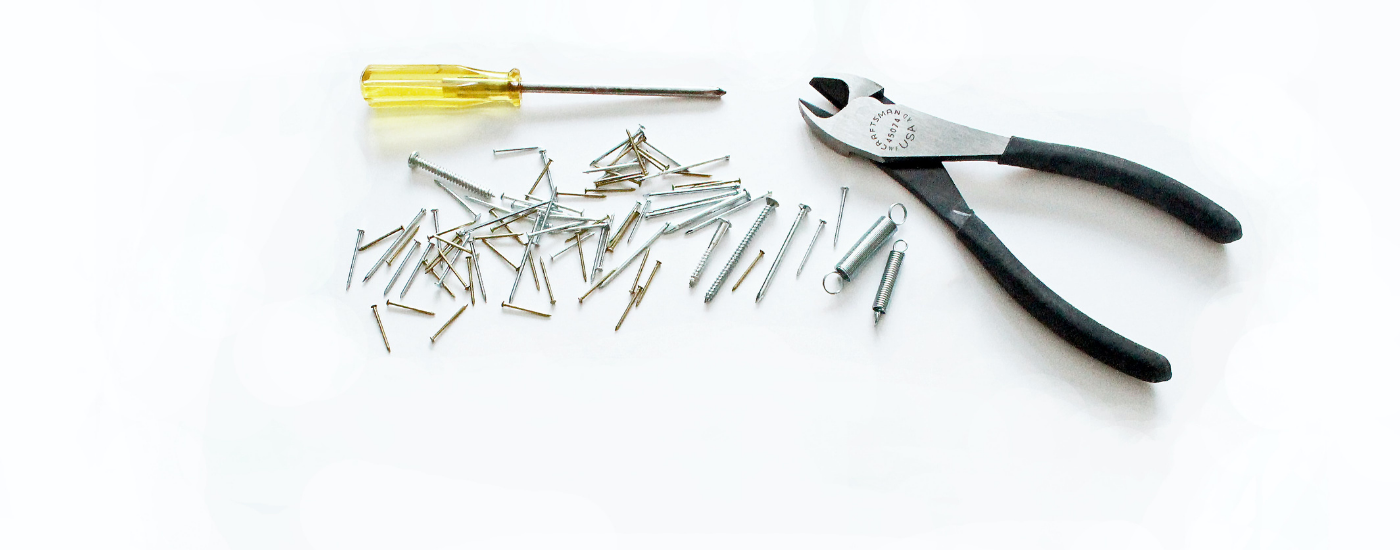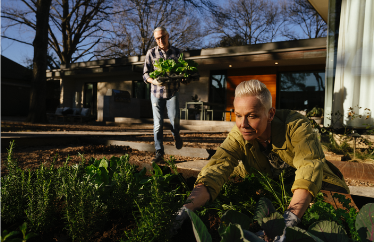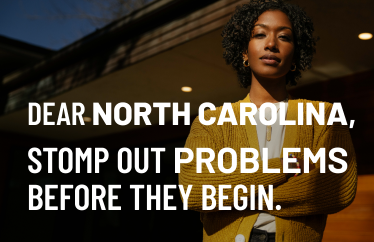In March 2020, the World Health Organization declared COVID-19 a pandemic. Since then, home improvements, renovations and home buying are on the rise. Last year alone, 16 million people moved in search of larger spaces, driving a boom in the housing market. To clarify how this new era in homeownership is affecting Americans, we surveyed 1,000 homeowners about what changes they’ve made in the home and how they’re evaluating their future homes.
Overall, we learned that the pandemic is heralding a new era of homeownership, one in which homeowners invest more in their properties for added comfort and an inherent need to protect their largest financial asset: the home.
Twice as many homeowners spent $10,000+ on their homes than in the previous year due to increased time at home. And 71% of homeowners say they’ll continue to upkeep their home with the same level of investments in home improvements, even after pandemic restrictions decline.
More Time in the Home Has Skyrocketed Home Improvements
Data shows that the pandemic has paved the way for investments inside and outside the home.
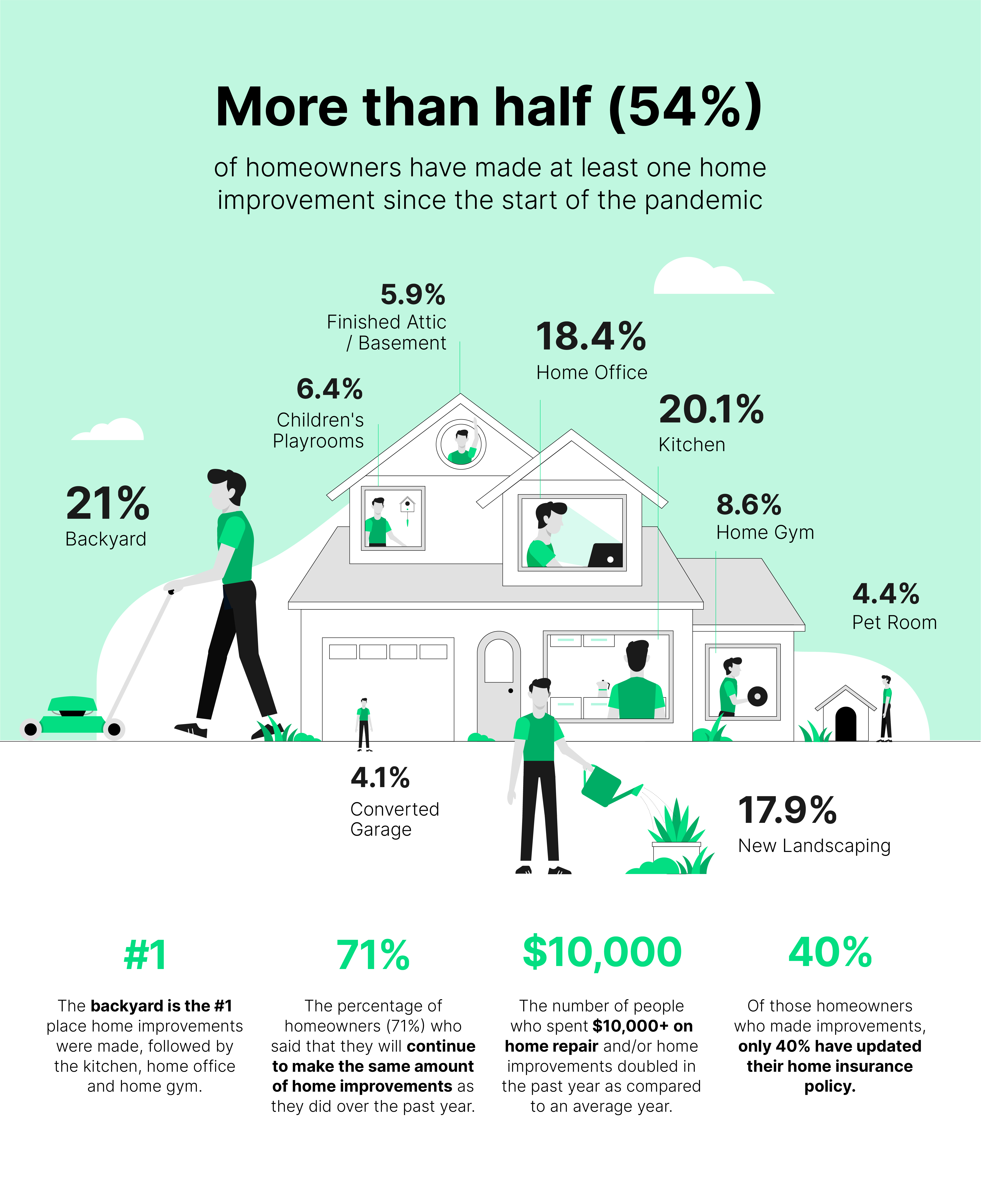
Previous recessions and economic shocks have traditionally slowed the housing and home improvement market; however, the opposite is happening during the COVID19 pandemic. Our survey found that 12.3% of these homeowners bought a home or property within the last year. More than half (54%) made improvements to their property since the beginning of the pandemic.
Our 'homes' have had to take on new responsibilities in 2020. They became our new office, distance learning classroom, home gym, etc. That explains why 66% of respondents spent more than $1,000 on home repair and/or home improvements this past year. Some people needed more change than others because the population that spent $10,000+ doubled in the past year compared to an average year (from 5% to 10%).
While our homes shoulder more responsibility than ever before, the silver lining is that it's led many homeowners to be more aware and active homeowners. 52% of homeowners said they’ve become more proactive when it comes to home maintenance in the past year. Interestingly enough, the newest generation of homeowners, Millennials, were the most proactive at 64%. This signals a strong start for this new generation of homeowners amidst the economic hard times being experienced.
Home Maintenance Took a Front Seat During Lockdown
While the pandemic limited activity outside of the home, it drew more people to take action inside the home. The data says homeowners no longer sit by passively, waiting to react to issues that may come up around the home. 1 in 3 homeowners set a home maintenance checklist or routine that they follow, and of this group, 76% believe they’ve become even more proactive in taking care of their home in the past year.
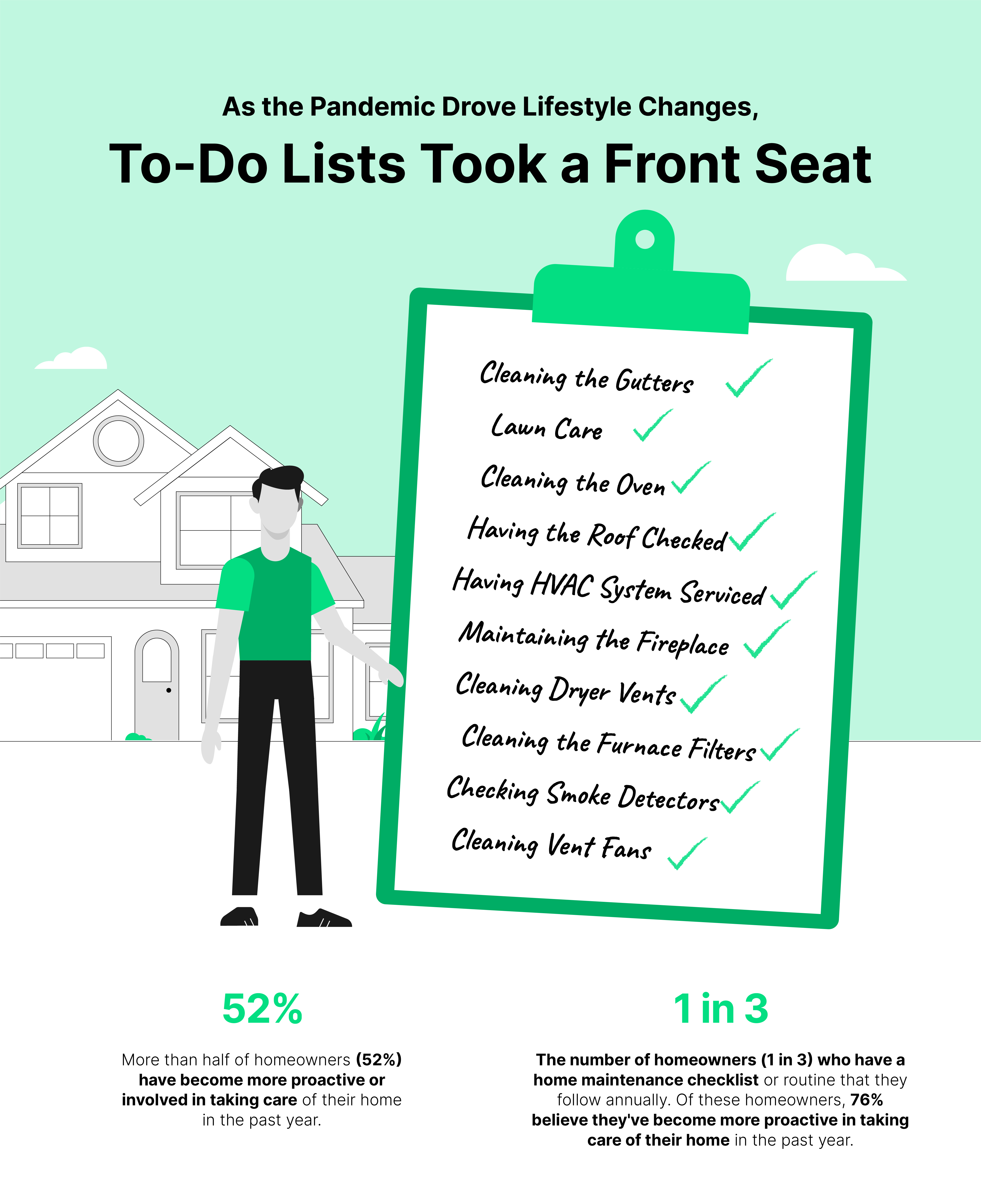
Home maintenance can be a tedious task, and some are more unpleasant than others, but being proactive leads to less repair work and strain on homeowners in the long run.
While we continue to see a much more proactive homeowner approach to home improvement and repairs, the same cannot be said for those same homeowners thinking proactively about their home insurance. While more than half of respondents made changes to their homes, only 40% said they updated their home insurance policy.
To indeed be proactive, you should let your insurance company know about your remodeling plans before they are executed. This way, you can ask them if you should update your homeowners insurance and whether you need other insurance types to protect you financially during the project. But if you choose to wait until after your project, make sure to let your insurance company know about the improvements you made. This way, you can get expert advice on whether you get a discount because you installed a burglar alarm or if that new hot tub needs any extra coverage. Now is an excellent time to discuss these modifications with your insurance professional to best update your policy.
Millennials led the pack again for respondents who said they did reach out to their home insurance company after making changes to their homes at 55%. When it comes to both major and minor home improvement projects, a proactive POV of the home goes a long way.
Dreaded Household To-do List Tasks Are Still Neglected
Americans are completing approximately 511 million home service jobs each year, 16 jobs per second (!).
Almost all homeowners surveyed said they have at least one task that they absolutely dread. Whether it is cleaning the gutters, mowing the lawn, or cleaning the oven--taking care of it before it has a chance to become a problem will save you time and money. According to Cash Value of Home Maintenance, every dollar spent on maintenance prevents up to $100 of repair costs.
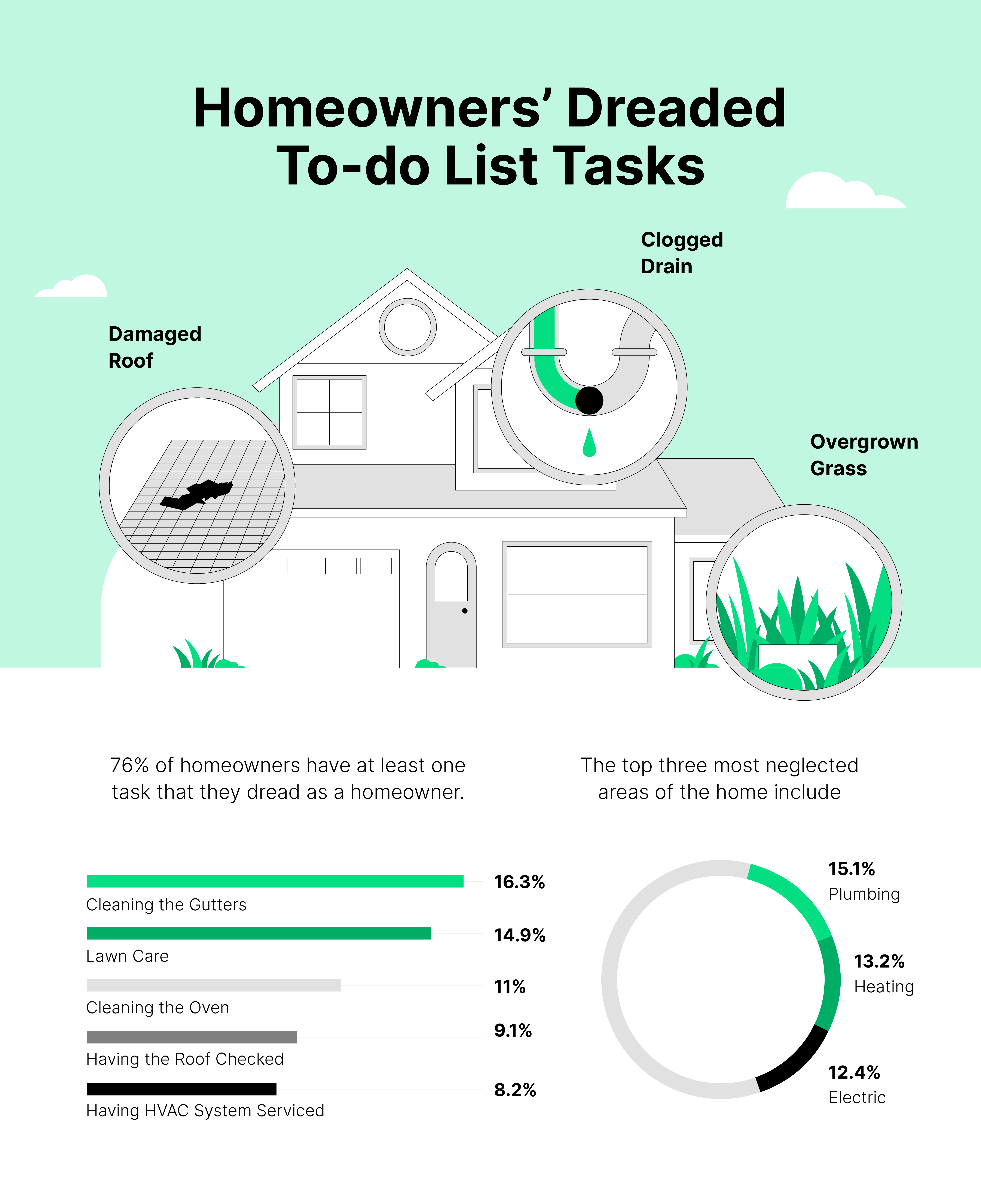
There’s still hope for these homeowners and what can happen when you give your home a little T-L-C. We’ve done the heavy-lifting and broke down the most critical home maintenance tasks into monthly, quarterly, yearly and seasonal checklists. Being proactive ensures your home runs smoothly and minimizes the number of unwelcome surprises that can pop up over time.
Millennials Are Investing the Most Into their Homes, Compared to Other Generations
Millennials have long challenged the business norms since joining the workforce. Now that they are the largest generation in the U.S. labor pool, they also make up most remote workers. Known advocates of the flexibility of working from home pre-pandemic, this group quickly took the lead in upgrading and prioritizing their WFH setup.
In the past year, 52% of total respondents spent money on new or upgraded office equipment. Items like a computer desk, upgraded wifi, or video conferencing equipment. But it was Millennials that have been taking it to the next level. Upgraded video conferencing equipment like ring lights, microphones, and green screens were purchased the most by Millennials at 71%, followed by Gen Z with 16th%. 71% of millennials also purchased a smart wifi router, while only 6.7% of boomers made the leap to smart wifi.
Interestingly, 75% of millennials said that completing a home improvement project has enabled them to take a personal hobby to the next level. What personal hobby, you ask? Creating content of course, at 77%, followed by baking at 68% and personal fitness close behind with 65%.
Smart Home Products Continue to Grow in Popularity and Dominate Homes, Across the Country
With deeper investments made in homeownership, it was not surprising to find that more homeowners were purchasing smart home devices. Smart home devices play an important role in protecting the things that matter most - your home and the people in it. In 2010, people owned 12.5 billion networked devices, and it is now estimated that by 2025, that number will have climbed to more than 50 billion.
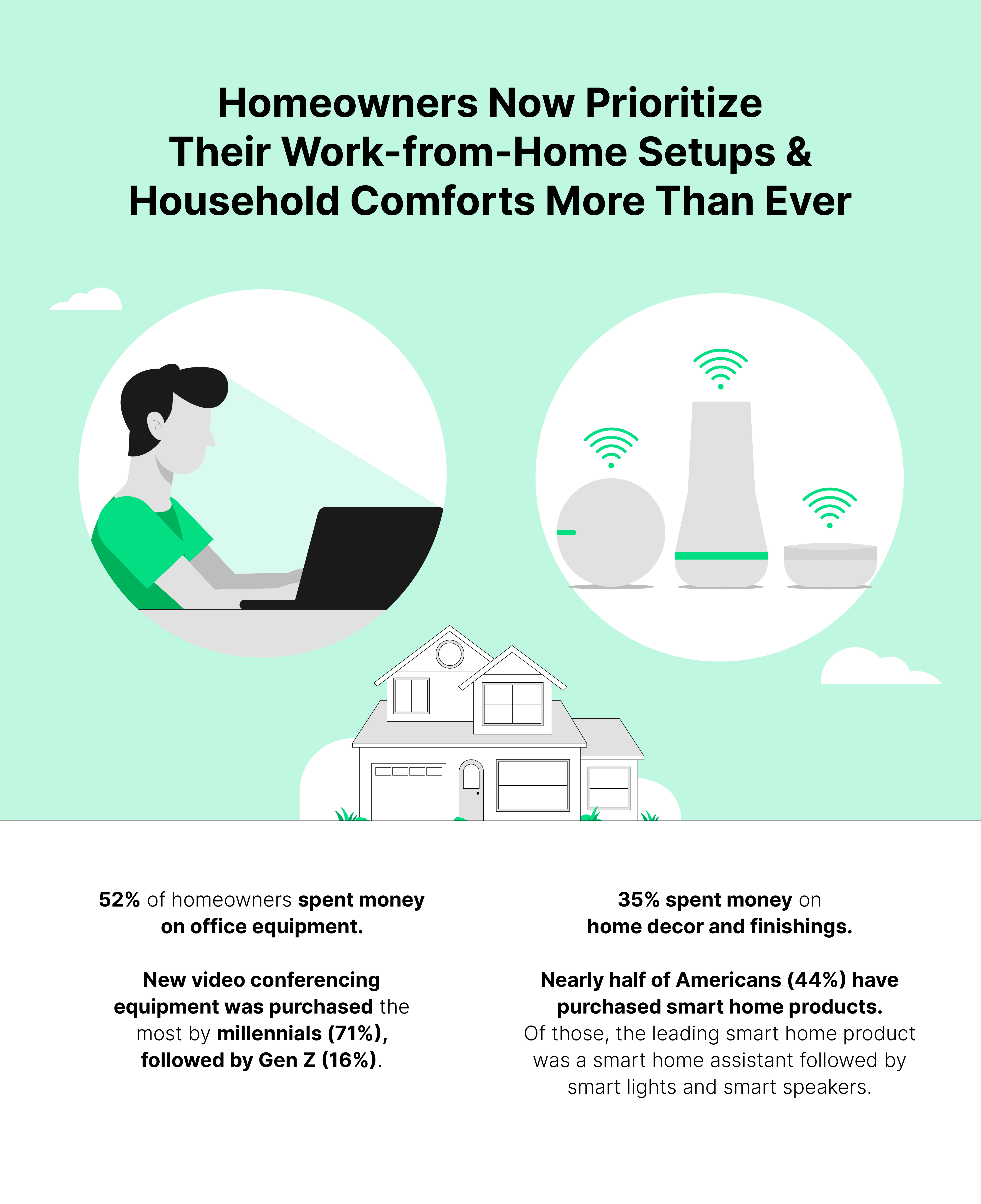
Nearly 50% of homeowners surveyed (44.6%) purchased new smart home products in the past year. The most popular smart home product purchased was smart home assistants, followed by smart lights and smart speakers. We also learned that your work from home setup influences your smart home setups. Legal professionals sprung for smart home devices the most when compared to other professions. Maybe those long hours of having to work-from-home inspired people to choose coziness. Members of the military bought the smart home assistants at 40%, which is an ironic correlation to draw because if there’s one group used to running on efficiencies, it would be our folks in uniform.
Home - ReImagined
The home used to be a place of passive experiences, coming home from work and school, enjoying a meal with family and getting in some much-needed Zzz’s. Today, the homeowner journey looks much different, including how much time and money is spent there. With personal and financial investments in the home growing at a shockingly fast rate, these types of behaviors are a silver-lining that can lead to better outcomes for owners, safer homes, and more fruitful long-term investments in homeownership.
According to Rick McCathron, Hippo’s President, “This past year’s shift in how we live in our spaces has fundamentally changed the way we take care of our homes, with long-term effects. Our homes are no longer places where we spend minimal time —with our households being the primary haven where we work, socialize and rest, we’ve discovered that more people are becoming proactive in taking care of their homes. This increase in usage is leading to a larger amount of home improvements, and at Hippo, we’re always underscoring the importance of maintaining your home and ensuring that homeowners are getting the best possible protection when upgrades are made.”
Much more than insurance, Hippo takes a holistic approach to home wellness. It meets consumers where they are and serves as a command line for everything related to property protection. Hippo’s technology has created a clear path to proactive homeowner protection, which reduces a customer’s chance of losses and fewer claims. This efficiently scales the company’s insurance products to reach more homeowners. It is the only insurance company with a full commitment to its customers’ homes and safeguarding their property’s essentials.
